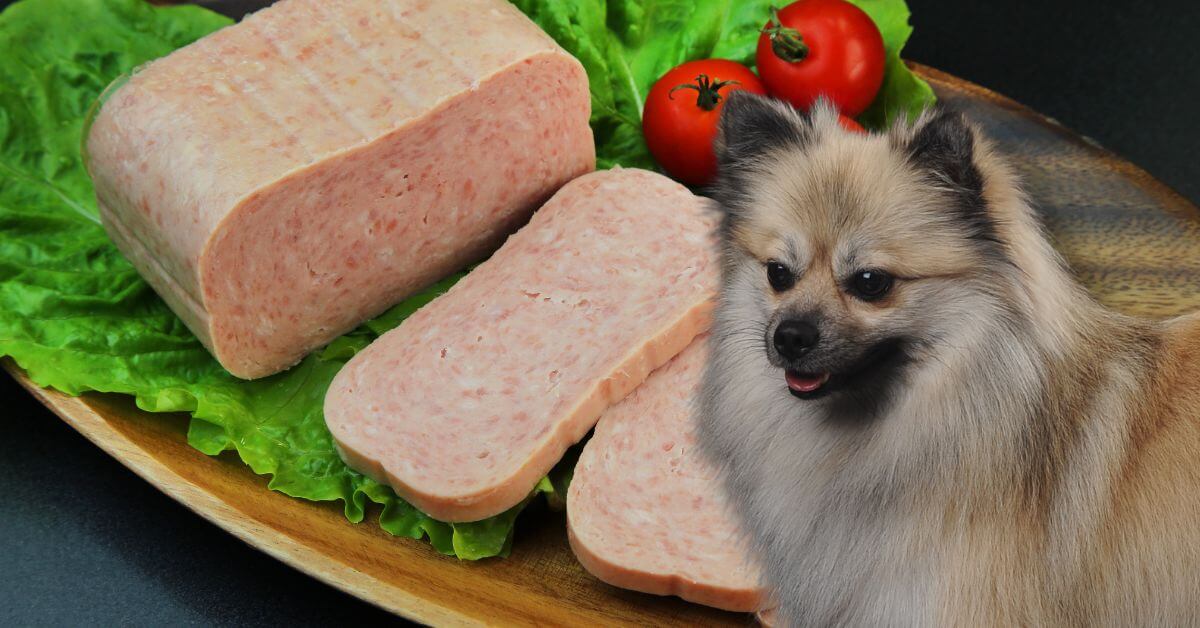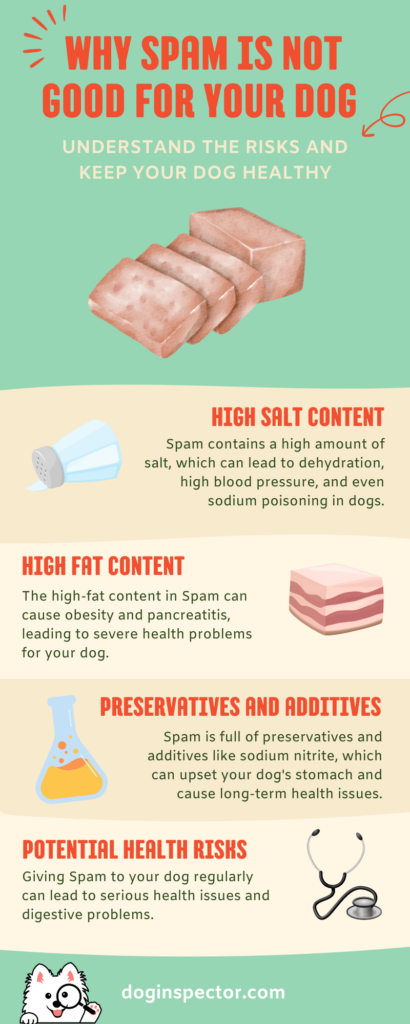Can Dogs Eat Spam?
While Spam isn’t instantly toxic or harmful for dogs, it’s really not recommended as part of their regular diet. If your dog accidentally snatches a small piece, they should be fine, but giving them Spam as a regular thing can cause some long-term health issues.

Spam contains high levels of salt, additives, fat, nitrates, and preservatives, which are damaging to a dog’s health. Too much salt causes dehydration and, in severe cases, sodium ion poisoning. The additives and preservatives can lead to gastrointestinal upset and long-term health problems. The high-fat content can contribute to obesity, pancreatitis, and other health issues, while nitrates can cause digestive and other health problems over time. Eating Spam regularly can lead to physical and behavioral consequences depending on your dog’s size.
What is Spam made of?
Spam is a canned meat product made from a combination of pork and ham, along with several other ingredients. The primary components of Spam include:
- Pork shoulder and ham: These are the main meat sources in Spam, providing the bulk of its protein content.
- Salt: Spam contains a significant amount of salt. It’s there as a preservative and flavor enhancer.
- Water: This helps to maintain the moisture and texture of the product.
- Modified potato starch: This is added to bind the meat together and give Spam its distinctive texture.
- Sugar: Used in small amounts to balance the flavors.
- Sodium nitrite: This preservative helps to prevent bacterial growth and maintain the pink color of the meat.
These ingredients are combined, cooked, and canned, and while they are safe for human consumption in moderation, the high salt and preservative content make Spam a really unhealthy option for dogs.
Sodium in Spam and why it’s dangerous for dogs
Let’s talk about the sodium content in Spam. It’s pretty high! Just one serving (2 oz or 56g) has 790mg of sodium. That’s 34% of the daily recommended amount for humans, and it’s a lot for our furry friends. Too much salt isn’t good for dogs—it can cause high blood pressure, dehydration, and even serious conditions like sodium ion poisoning. So, while a tiny taste might not hurt, using Spam as a regular snack is definitely not a good idea. And sodium poisoning is not a joke!
| X-Small | Small | Medium | Large | X-Large | XX-Large |
|---|---|---|---|---|---|
| Yorkie, Chihuahua | Pug, Boston Terrier, Poodle | Beagle, Scottish Terrier | Boxer, Cocker Spaniel | Retriever, German Shepherd | Great Dane, St. Bernard |
| 1-10 lbs. (0.45-4.6 kg) | 11-25 lbs. (5-11.4 kg) | 26-40 lbs. (11.8-18.2 kg) | 41-70 lbs. (18.6-31.8 kg) | 71-90 lbs. (32.3-40.9 kg) | 91-110 lbs. (41.4-50 kg) |
| 0.05 Tbsp | > 0.5 Tbsp | > 1.3 Tbsp | > 2 Tbsp | > 3.5 Tbsp | > 4.5 Tbsp |
For small dogs weighing between 11 and 25 pounds (5 to 11.4 kg), it takes about half a tablespoon of sodium chloride to risk sodium poisoning. Considering that one serving of Spam contains 790mg of sodium, a small dog would need to consume almost nine servings of Spam to reach this dangerous level (so if they have a piece, don’t panic!). However, even smaller amounts can lead to health issues like dehydration and high blood pressure. To keep your dog healthy and safe, it’s best to avoid feeding them Spam altogether.
Potential health risks of feeding Spam to dogs
Feeding your dog Spam can have several health risks, and we’ll discuss some of the most common issues. If your dog ate Spam and feels unwell, please call your vet. And don’t give them any processed meat!
Spam can cause salt poisoning
We mentioned that salt is bad for dogs, but you may wonder why and what happens. Salt poisoning occurs because dogs have a lower tolerance for sodium compared to humans. Their bodies aren’t designed to process high amounts of salt, which can quickly overwhelm their system. Dogs primarily rely on their kidneys to filter out excess sodium, but when consumed in large quantities, it can lead to dehydration and an imbalance in electrolytes.
High-fat processed meats, like Spam, can cause pancreatitis
Dogs’ digestive systems can’t handle large amounts of fat. Their pancreas produces enzymes to break down fat, but excessive fat intake can overwhelm this process, leading to inflammation and pancreatitis. Additionally, high-fat diets contribute to obesity, pancreatitis, and other metabolic disorders. Excess weight places additional pressure on a dog’s joints, heart, and overall health, while pancreatitis, an inflammation of the pancreas, can be painful and life-threatening.
There’s a comprehensive study on pancreatitis in dogs, its causes, and risk factors. This study shows that various factors can trigger pancreatitis in dogs. High-fat diets and consuming unusual foods, table scraps, or trash are significant dietary risks. Other causes include lipid disorders, certain medications and toxins, hormonal imbalances, genetic predispositions in some breeds, and ingestion of harmful substances.
Nitrates can cause gastrointestinal upset in dogs
Feeding dogs foods that contain additives, preservatives, and nitrates, such as Spam, is not a good idea. These substances are included in processed foods to enhance flavor, extend shelf life, and maintain color, but they can be harmful to dogs.
Nitrates, including sodium nitrite, are used in Spam for curing and preserving the meat. While small amounts are generally safe, high levels of nitrates can convert into nitrites in the body, which can interfere with oxygen transport in the blood. This can lead to conditions like methemoglobinemia, where the blood’s ability to carry oxygen is reduced. Dogs affected by high nitrate intake may exhibit symptoms such as weakness, rapid breathing, and disorientation. There’s a study about nitrate poisoning in cats and dogs that ate pet food rich in nitrates, so if you have a choice, you should never give your dogs any nitrate-rich foods.
Dogs’ bodies are not equipped to handle the chemical load from additives, preservatives, and nitrates found in processed meats like Spam. These substances can disrupt their digestive systems, strain their liver and kidneys, and lead to long-term health issues. Sticking to natural, unprocessed foods can help ensure your dog’s health and well-being. This is mostly true for all processed meats!

What to do if your dog accidentally eats a lot of Spam
First of all, don’t worry. Spam isn’t toxic for dogs. However, please check the table for salt poisoning above and see if your dog is at risk.
Depending on their size, if your dog accidentally eats a lot of Spam, they may experience some issues, but in most cases, they will be perfectly fine. We are writing to reassure you that you didn’t intentionally want to harm your dog. But accidents happen, and in the case of accidents, you should do the following. First, monitor for symptoms. Watch your dog for any signs of an upset stomach, like vomiting, diarrhea, or lethargy. It’s important to watch for these signs so you can take action if needed.
Switch to bland diet
Next, control their diet. Give your dog’s stomach a break by not feeding them for 24 hours, but make sure they have access to water. If your dog isn’t drinking, you can use a dropper or syringe to offer small amounts of water every hour. After 24 hours, feed your dog four or five small, light meals throughout the day. Choose easily digestible foods like chicken, fish, or scrambled eggs with a bit of rice. If your dog handles the light meals well, slowly reintroduce their regular food over the next few days.
Offer some probiotic food
Adding probiotics to your dog’s diet can help restore the balance of good bacteria in their gut. Live yogurt works well—a teaspoon twice a day for small dogs and up to two tablespoons twice a day for larger dogs should do the trick. Alternatively, you can use a probiotic supplement from your pet shop.
Call your vet
Finally, if your dog doesn’t improve quickly or shows any serious symptoms, contact your vet right away to get them checked out. Follow these steps and make sure your dog stays healthy and comfortable after their Spam binge. Remember, a little accident with Spam is usually nothing to worry about!
Love, life and fur forever!
FAQs
Can dogs eat raw Spam?
No, dogs should not eat raw Spam. Raw Spam still contains high levels of salt, fat, and nitrates. It’s best to avoid giving your dog any form of Spam to prevent potential health issues.
Can dogs eat low sodium Spam?
While low-sodium Spam might seem like a better option, it’s still not ideal for dogs. Even with reduced sodium, low sodium Spam contains nitrates that can be harmful to your dog’s health. It’s better to stick to healthier, natural treats that are specifically formulated for dogs.